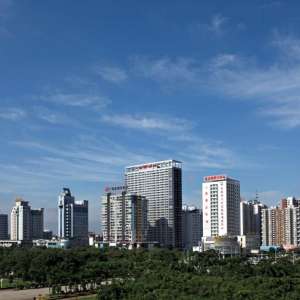The Ultimate Guide to Shipping from Taizhou to the US
Latest update on 15 August, 2024 by Aaron Kwok – Marketing Analyst at FreightAmigo
Taizhou, a bustling port city located in the eastern Zhejiang Province of China, has become a significant hub for international trade, particularly with the United States. The Taizhou Ocean Port, boasting modern infrastructure and efficient handling capabilities, serves as a crucial gateway for goods flowing between China and the US. For businesses seeking to expand their reach into the American market or optimize their global supply chains, understanding the complexities of freight transport from Taizhou to the US is essential.
This comprehensive guide aims to provide a detailed overview of the logistics involved in shipping goods from Taizhou Ocean Port to the United States. We will delve into key considerations, processes, and best practices, equipping you with the necessary insights to navigate this dynamic trade corridor effectively.
Want To Compare The Best Express, Air Freight, Sea Freight, Rail Freight & Trucking Rates So As To Have Better Control On Cost?
Understanding the Taizhou-US Freight Corridor
The Taizhou-US freight corridor is a vital trade route connecting two of the world’s largest economies. Taizhou’s strategic location, close to the Yangtze River Delta and with access to a robust transportation network, makes it an ideal starting point for shipments to the US. The Taizhou Ocean Port, with its deep-water berths and advanced cargo handling facilities, facilitates the smooth flow of goods.
When it comes to transporting freight from Taizhou to the US, businesses have multiple options:
- Sea Freight: The most common and cost-effective method involves transporting goods by sea from Taizhou Ocean Port to various US seaports, such as Los Angeles, Long Beach, New York, or Savannah.
- Air Freight: For time-sensitive or high-value goods, air freight from Taizhou to the US may be the preferred choice, although it is generally more expensive than sea freight.
- Intermodal Transport: Combining sea freight with other modes of transportation, such as rail or road, can offer greater flexibility and faster transit times for certain types of cargo. This is particularly relevant for inland destinations in the US.
Navigating the Logistics of Freight Shipments
When planning freight shipments from Taizhou to the US, several key considerations and processes are crucial:
1. Customs Clearance and Documentation
Ensuring compliance with customs regulations in both China and the US is paramount. This includes obtaining the necessary permits, licenses, and documentation, such as commercial invoices, packing lists, bills of lading, and certificates of origin. Businesses should familiarize themselves with the specific requirements and work closely with freight forwarders or customs brokers to streamline the clearance process.
2. Mode of Transportation and Route Planning
Selecting the most appropriate mode of transportation, whether it’s sea, air, or intermodal, depends on factors such as the type of goods, urgency of delivery, and cost considerations. Freight forwarders can assist in mapping out the most efficient routes and coordinating the various stages of the shipment process.
3. Packaging and Labeling
Proper packaging and labeling of goods are essential to ensure the safe and secure transport of freight. This includes using appropriate packaging materials, adhering to size and weight restrictions, and clearly marking shipments with all necessary information, such as the destination, contents, and handling instructions.
4. Insurance and Risk Management
Protecting your cargo during transit is crucial. Businesses should consider acquiring appropriate insurance coverage, such as marine cargo insurance, to mitigate the risks of loss, damage, or delays during the freight journey.
5. Delivery and Last-Mile Logistics
The final leg of the freight journey, known as the “last-mile” logistics, involves the efficient delivery of goods from the US port to the final destination. Coordinating with local transportation providers and ensuring timely delivery is key to the overall success of the freight shipment.
Navigating the Logistics of Freight Shipments
When planning freight shipments from Taizhou to the US, several key considerations and processes are crucial:
1. Customs Clearance and Documentation
Ensuring compliance with customs regulations in both China and the US is paramount. This includes obtaining the necessary permits, licenses, and documentation, such as commercial invoices, packing lists, bills of lading, and certificates of origin. Businesses should familiarize themselves with the specific requirements and work closely with freight forwarders or customs brokers to streamline the clearance process.
2. Mode of Transportation and Route Planning
Selecting the most appropriate mode of transportation, whether it’s sea, air, or intermodal, depends on factors such as the type of goods, urgency of delivery, and cost considerations. Freight forwarders can assist in mapping out the most efficient routes and coordinating the various stages of the shipment process.
3. Packaging and Labeling
Proper packaging and labeling of goods are essential to ensure the safe and secure transport of freight. This includes using appropriate packaging materials, adhering to size and weight restrictions, and clearly marking shipments with all necessary information, such as the destination, contents, and handling instructions.
4. Insurance and Risk Management
Protecting your cargo during transit is crucial. Businesses should consider acquiring appropriate insurance coverage, such as marine cargo insurance, to mitigate the risks of loss, damage, or delays during the freight journey.
5. Delivery and Last-Mile Logistics
The final leg of the freight journey, known as the “last-mile” logistics, involves the efficient delivery of goods from the US port to the final destination. Coordinating with local transportation providers and ensuring timely delivery is key to the overall success of the freight shipment.
Best Practices for Efficient Freight Management
To ensure the smooth and successful transport of freight from Taizhou to the US, businesses should consider the following best practices:
1. Establish Strong Partnerships
Developing close relationships with reliable freight forwarders, customs brokers, and transportation providers can significantly enhance the efficiency and reliability of your freight operations. These partners can provide valuable insights, resources, and support throughout the entire shipment process.
2. Optimize Supply Chain Visibility
Implement robust supply chain management systems and tools that provide real-time visibility into the status of your freight shipments. This allows for better decision-making, proactive problem-solving, and improved customer communication.
3. Embrace Digital Technologies
Leverage digital technologies, such as online freight booking platforms, automated customs clearance systems, and blockchain-based traceability solutions, to streamline the freight management process and reduce the risk of errors or delays.
4. Maintain Flexible and Adaptable Strategies
Be prepared to adjust your freight management strategies as market conditions, regulations, or customer requirements change. Staying agile and responsive to these evolving factors can help you maintain a competitive edge and ensure the continued success of your freight operations.
5. Prioritize Sustainability and Environmental Responsibility
As concerns about the environmental impact of freight transportation grow, consider adopting sustainable practices, such as using more fuel-efficient modes of transport, reducing waste, and partnering with eco-conscious logistics providers.
Conclusion
The Taizhou-US freight corridor is a dynamic trade route that offers significant opportunities for businesses looking to expand their reach into the American market. By understanding the logistics, best practices, and key considerations involved in managing freight shipments from the Taizhou Ocean Port to the US, companies can optimize their supply chain operations, reduce costs, and enhance their overall competitiveness.
Whether you’re a seasoned logistics professional or new to international trade, this comprehensive guide has provided you with the knowledge and insights necessary to navigate the complexities of this important freight route. By leveraging the right partnerships, embracing digital technologies, and maintaining a flexible and adaptable approach, you can ensure the efficient and successful transport of your goods from Taizhou to the US.
If you are looking for logistics experts, Please Go To The FreightAmigo Page For Inquiries
Read more:
A Comprehensive Guide to Shipping from Zhuhai to US | FreightAmigo
A Comprehensive Guide to Shipping From Wuhan To US | FreightAmigo
A Comprehensive Guide To Freight From Beijing To US | FreightAmigo
If you have any inquiries on logistics / supply chain, feel free to contact FreightAmigo now:
Chat with us online | Hotline: +852 28121686 | WhatsApp: +852 27467829










































